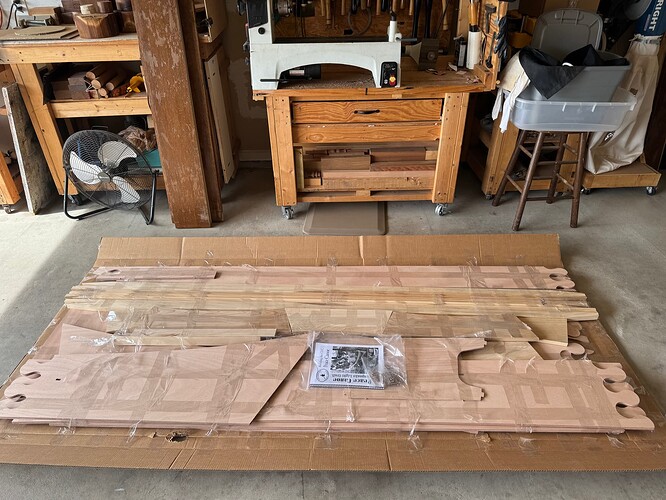YO HO HO – Jingle Bells
Well, it only feels like Christmas for Grandpa because his Peace Canoe kit was delivered today !!
And like any Christmas morning, the package straps were being cut before the delivery driver drove away.
After cutting away 2.74 miles of packing tape from a well packaged kit, all of the individual pieces were separated and ready for inventory. Happy to report that “all present and accounted for” was proclaimed.
Now where are my grandkids to assist in this build ?? It is going to be a long month waiting until they are out of school and it will be difficult not to start the project without them – ugh. Grandpa is going to need to take a patience pill or 2 and perhaps do some lathe work while waiting.
I will chat more down the line as I already have a few “application” questions.
2 Likes
Just a tip about the packing tape - double check that you got it all off and clean off any glue residue. I have been finding bits and pieces of packing tape that I missed and there has been quite a bit of glue residue I have found. I didn’t start paying attention until I either fiberglassed over a piece of tape or their was enough glue residue to prevent the epoxy from penetrating and I had to cut out a piece of fiberglass from the floor of my Jimmy Skiff.
That is a capital idea - thanks for the tip. I will be like Sherlock looking over every single board - both faces. Better to not learn the hard way …
More power to you if you want the kids involved in every aspect of the project, but consider… Waiting for epoxy to harden is a little like watching a pot waiting for it to boil. If your time with the young help might be limited, or they are young enough that attention spans will be short, you could get them involved in the more satisfying/rapid progress parts of contruction if you elect to do a few first steps in advance like completing the puzzle joints on the hull planks and doing some surface pre-coating/sanding on pieces that require (or benefit from) pre-coating prior to assembly. That way, when the young help arrives you’ll be in a better place to actually start boat assembly, rather than doing an hour or two worth of epoxy work and then saying “Well, that’s all we can do today kids, so now go play and come back tomorrow.”
Well, if you have the grandchildren with you for an extended stay, as I think you suggested in your earlier post, you can have other adventures up your sleeve while waiting for epoxy to cure. Take 'em on a long hike, making sure they walk at least twice as far as you do. You know, “Say, young’n’s, what do you suppose is up that branch of the creek? Why don’t you dash up there and report back whether it’s worth a look.” Of course, always have your folding camp stool along so you don’t have to sit on the ground (from which you will than have to get up!) while they explore. <;-)
Seriously, I was fortunate that my adult offspring and grandchildren lived within easy driving distance of me when we built a Passagemaker Dinghy as a family project about ten years ago. Those grandchildren are mostly young adults now. I wish you all joy of making great memories with yours! <;-)
I hope to keep them entertained with the “boat building” and other side activities when their attention begins to lapse. I know that after a few hours of “work” the Xbox, YouTube, and whatever else will be calling them and they may not be able to resist. That is okay; we do not have a time clock.
Fortunately, with this particular kit, we should be able to see some progress pretty quick. One of the main reasons I chose this kit is that there is NO epoxy or fiberglass in the build. I thought for a first boat project I would keep it simple with relatively quick “rewards” in seeing parts come together. I told them that we are building a wooden Lego – that comment got their undivided attention.
We will see . . .
Hi Michael,
I hope to make it an enjoyable experience for them. I intend to let them do everything that they are capable of doing on this project. Drive every nail, screw, squeeze the adhesive out of the caulk gun and do the painting (outside in old clothes so as not to feel the wrath of the MOM).
I will have a log book for each of them and they can record their “building adventure” with photos that we take. And of course, we will play the boat song (Boats To Build by Guy Clark) every morning before we start.
We should see quick progress (as mentioned in an earlier post) so maybe I can keep their enthusiasm up.
I think I read somewhere that Root Beer floats help !!
Here is a very nice sentiment in song that fits this thread. “Wooden Boat” by Del Suggs. https://www.youtube.com/watch?v=HSFjistk7i8 If you’ve never heard his music, look him up. Some great music.
Hey Jeff, I like the song. Now we will have two songs !!
Heading to the iTunes store.
